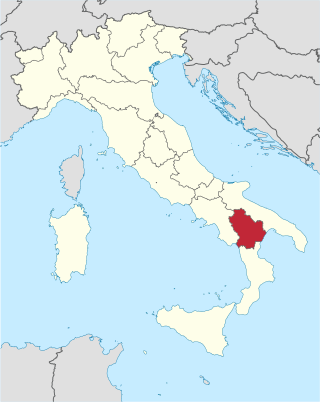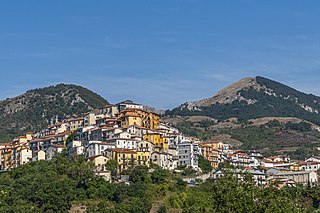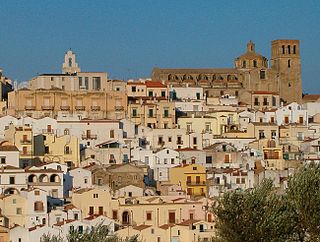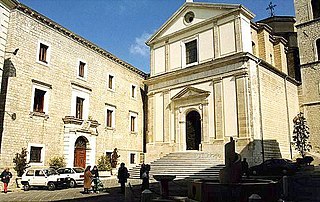
The House of Orsini is an Italian noble family that was one of the most influential princely families in medieval Italy and Renaissance Rome. Members of the Orsini family include five popes: Stephen II (752–757), Paul I (757–767), Celestine III (1191–1198), Nicholas III (1277–1280), and Benedict XIII (1724–1730). The family also included 34 cardinals, numerous condottieri, and other significant political and religious figures. The Orsini are part of the Black nobility who were Roman aristocratic families who supported the Popes in the governance of the Papal States.

Basilicata, also known by its ancient name Lucania, is an administrative region in Southern Italy, bordering on Campania to the west, Apulia to the north and east, and Calabria to the south. It has two coastlines: a 30-km stretch on the Tyrrhenian Sea between Campania and Calabria, and a longer coastline along the Gulf of Taranto between Calabria and Apulia. The region can be thought of as the "arch" of the "boot" of Italy, with Calabria functioning as the "toe" and Apulia the "heel".

Avigliano is a town and comune in the province of Potenza, in the southern Italian region of Basilicata.

San Fele is a town and comune in the province of Potenza in the Basilicata region of southern Italy.

Bella is a town and comune in the province of Potenza, in the southern Italian region of Basilicata. It is bounded by the comuni (municipalities) of Atella, Avigliano, Balvano, Baragiano, Muro Lucano, Ruoti, and San Fele.

Cancellara is a town and comune in the province of Potenza, in the Southern Italian region of Basilicata. It is bounded by the comuni of Acerenza, Avigliano, Oppido Lucano, Pietragalla, Tolve, Vaglio Basilicata.

Melfi is a town and comune in the Vulture area of the province of Potenza, in the Southern Italian region of Basilicata. Geographically, it is midway between Naples and Bari. In 2015 it had a population of 17,768.

Gesualdo is an Italian town in the province of Avellino, itself in the region of Campania. It is called "The city of the Prince of Musicians" in honour of Carlo Gesualdo. It has many palaces, fountains, belvederes, and a historical center, which was partially restored after the Irpinia earthquake in 1980.

Maschito is a town and comune of the province of Potenza, in the Basilicata region of southern Italy. Like other towns in the Vulture area, Maschito was repopulated by Albanian refugees after the occupation of Albania by the Ottoman Empire.

Marsicovetere is a town of and comune in the province of Potenza, in the Southern Italian region of Basilicata.

Ferrandina is a town and comune in the province of Matera, in the Southern Italian region of Basilicata. It is a center for production of high quality olive oil.
Salandra is a town and comune in the province of Matera, in the Southern Italian region of Basilicata.

Cirigliano is a town and comune in the province of Matera, in the Southern Italian region of Basilicata.

Torremaggiore is a town, comune (municipality) and former seat of a bishopric, in the province of Foggia in the Apulia, region of southeast Italy.

The Archdiocese of Potenza-Muro Lucano-Marsico Nuovo is a Latin diocese of the Catholic Church in Basilicata, southern Italy, created in 1986. In that year the Diocese of Muro Lucano was united into the Archdiocese of Potenza e Marsico Nuovo, which had been elevated to an archdiocese in 1973, and made a metropolitan see in 1976. The historical Diocese of Potenza was united with the Diocese of Marsico Nuovo in 1818.
The Latin Catholic Diocese of Muro Lucano, in the southern Italian region of Basilicata, existed until 1986. In that year it was united into the archdiocese of Potenza-Muro Lucano-Marsico Nuovo.

The Archdiocese of Matera-Irsina is a Latin archdiocese of the Catholic Church in Basilicata, Italy. It has existed under this name since 1986. The archbishop is seated at Matera Cathedral.. It is a suffragan of the Archdiocese of Potenza-Muro Lucano-Marsico Nuovo.
The 1694 Irpinia–Basilicata earthquake occurred on 8 September. It caused widespread damage in the Basilicata and Apulia regions of what was then the Kingdom of Naples, resulting in more than 6,000 casualties. The earthquake occurred at 11:40 UTC and lasted between 30 and 60 seconds.

The Castle of Muro Lucano is a castle in the commune of Muro Lucano in the Potenza province of the Basilicata region of southern Italy. It was originally built in the 9th century and parts of it are still inhabited by the Martuscelli family, relatives of Francesco Domenico Lordi who bought the castle in 1830.

The Cathedral of San Gerardo is the main church or duomo of the city of Potenza, capital of the province of the same name, and of the region of Basilicata, Italy. Since 1986 Potenza forms part of the archdiocese of "Potenza-Muro Lucano-Marsico Nuovo".
























